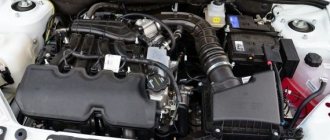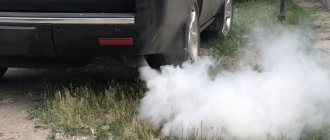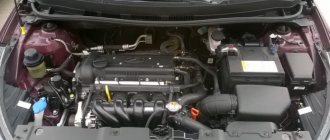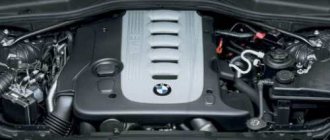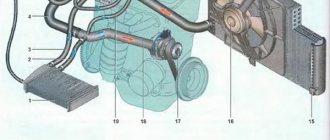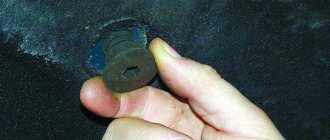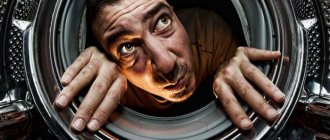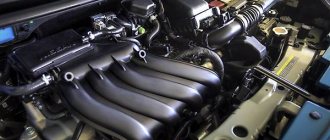In the life of motorists, a situation often arises when, when driving out onto the road and trying to accelerate, it is noted that the engine does not pull.
That is, the acceleration dynamics are very “sluggish”, the car is reluctant to pick up speed, and it feels like something is holding it back.
This problem can arise with almost any car - domestic or foreign, gasoline or diesel, with a carburetor power system and injector.
Often, a drop in traction is accompanied by additional symptoms - extraneous sounds appear when the engine is running, the engine may stall in one of the modes (usually at idle), the crankshaft speed is not stable and “floats”.
But this is not always the case; it happens that the unit behaves perfectly in all respects, but does not develop power.
Main reasons
There are many reasons for this phenomenon and in most cases they are associated with a malfunction of the systems and mechanisms of the power plant.
Some of them are trivial and very easy to fix, others require quite serious repairs.
The main problem with the fact that the engine does not pull is not related to eliminating the malfunction, but to finding it.
In some cases, it is very difficult to determine what caused the reduction in traction effort and you have to go through almost the entire engine.
Therefore, we will try to indicate the main reasons why the car accelerates very “sluggishly”.
Since engines on different cars have their own design features, we will consider specific models.
Checking the transmission
Sometimes the power unit can develop serious power, but it does not reach the wheels. If while driving you hear that the engine is working hard, but you don’t feel speed, then perhaps the automatic transmission system is slipping or there are blockages on the brakes.
To check, you need to drive onto a straight section, set the automatic transmission selector to position D, and then see how the car behaves. If the speed decreases, then diagnostics should be carried out. If everything is in order with the brakes, you need to go to a good service station and check the automatic transmission.
You can also check the parking brake. To do this, you need to go to free space. Warm up the car and then pull the handbrake. Next, press the brake pedal and set it to position D. Next, press the accelerator. If the engine keeps the rpm around 2000, then everything is fine with it. If it is less or more, you should go to a service station to test the automatic transmission.
Power drop on a VAZ carburetor engine
To begin with, let's take VAZ cars with a carburetor power system and an 8-valve timing system - VAZ-2109, VAZ-2110, VAZ-2114, VAZ-2115.
The same power plant is installed on these cars, so the reasons are identical.
Let's go through those components, due to malfunction of which a drop in dynamics may occur.
In general, the main reason that the engine does not pull is a change in the processes in the combustion chambers - a mismatch in the proportions of the air-fuel mixture, the combustion process is disrupted, the filling of the cylinders and the removal of exhaust gases does not occur as required.
Supply system
Very often, a drop in traction occurs due to the power system. Structurally, the carburetor fuel system used on cars from VAZ-2109 to VAZ-2115 is very simple and is almost completely mechanical, so identifying the cause is not particularly difficult.
A decrease in power can occur due to:
- Severely clogged fuel filter (its throughput drops and the pump is simply not able to pump the required amount of fuel);
- Contamination of the carburetor channels (the jets and fuel channels in this element have a small cross-section and debris often clogs them);
- There is air leakage in the area from the tank to the pump (because of this, the performance of the fuel pump drops sharply);
- Damage to the fuel pump membrane (a small crack in it leads to the fact that the vacuum required for pumping fuel is not created in the pump chambers);
- The fastening of the carburetor or intake manifold is loose (due to this, air leaks around the carburetor and the proportion of the air-fuel mixture is greatly disturbed);
- The hole in the fuel tank cap is clogged (because of this, a vacuum is created in the tank and it is much more difficult for the gas pump to pump gasoline out of it);
In addition to the elements responsible for supplying fuel, a drop in power also occurs due to severe contamination of the air filter element.
Ignition system
This system also takes part in the combustion of the mixture, which means a failure in its operation can affect power.
In carburetor engines VAZ-2110 and others, a decrease in traction can occur due to:
- Faulty spark plugs or changes in their thermal gap;
- Excessive wear of the contacts and the central electrode of the distributor;
- Voltage losses in high-voltage wires;
- Violations of the ignition timing.
Irregularities in the power supply and ignition systems most often cause a drop in power, so testing to identify the cause should begin with them.
If the operation of these systems does not raise suspicions, other components of the engine should be diagnosed.
Exhaust system, timing belt and crankshaft
Loss of traction can also occur due to the exhaust gas removal system, although problems with it rarely occur on carburetor engines.
The main reason here is the reduction in throughput due to large deposits in the muffler. Because of this, exhaust gases, without having time to escape from the cylinders, “choke” the engine.
The reasons for the drop in thrust are also often the gas distribution mechanism and the cylinder-piston group.
Here the reduction in power occurs due to:
- Violations of the thermal clearance of valves.
- Heavy carbon deposits on the valve plates and seats, or their burning.
- Occurrence of rings.
- Limit wear of the CPG.
- Cylinder head gasket failure.
In general, problems with the timing belt and CPG cause a drop in power in any engine - carburetor, injection, diesel. Therefore, we will not mention these mechanisms further.
Stop driving with the handbrake, and traction will appear by itself
If you always set your car's handbrake but forget to release it while driving, prepare for compromised traction. When driving with the handbrake, you get the feeling that the car accelerates very slowly and it is too difficult to gain momentum. The driver immediately puts pressure on the engine, putting pressure on the suspension or gearbox. But he can’t even think that it’s enough to lower the handbrake lever for the problem to solve itself. Moreover, driving with the handbrake for quite a long time will cause the following troubles with the car:
- the rear brake discs (or drums, depending on the design of the car) become too hot;
- heating sometimes causes deformation or excessive wear of these parts with various consequences;
- wear in any case will be very high and will become the reason for the mandatory replacement of the pads and disc after 100 kilometers of such a trip;
- the drum brake may even fall apart during movement, reducing the safety of the trip;
- Heat and excessive friction can cause failure of some parts of the chassis;
- The brake system may also develop other problems that require immediate solutions.
These are the troubles that await you if you simply forget to remove the handbrake lever to its original position before moving off. If you have a manual transmission, keeping an eye on the handbrake becomes even more difficult. With an automatic, it is enough not to accelerate from the first second, but to let the car show its readiness for the trip, let it start idling. If you regularly leave the handbrake on, just stop using the handbrake. Leave it in gear, choose more or less level parking spots.
VAZ injection engines
In injection engines VAZ-2110, 2112, 2114, 2115, both 8-valve and with a timing belt with 16 valves, it is more difficult to identify the cause of the decrease in power due to the more complex design of the main systems.
Supply system
Any injector consists of a mechanical executive part and an electronic control part, and problems can arise in both of them, which will lead to a drop in power.
Let's look at the mechanical part first. Here, cravings can be influenced by:
- Severely clogged mesh filter on the fuel pump;
- Decrease in fuel pump performance due to wear;
- The fine filter is dirty;
- Malfunction of the fuel rail pressure regulator;
- Clogged injectors;
- Fuel filter dirty;
- Air leak in the manifold.
In general, almost every element of the injector executive part can be the culprit for a decrease in dynamics.
The situation is approximately the same in the electronic component.
The operation of the engine with the injector is controlled by an electronic unit, which constantly monitors the parameters through sensors installed on different systems.
The number of these tracking elements is considerable and the breakdown of any of them leads to the fact that the ECU incorrectly evaluates the indicators on the basis of which it controls the executive part.
Thus, the lambda probe, DPKV, mass air flow sensor, DPZ, phase sensors, detonation sensors and coolant temperature sensors in the event of a breakdown lead to a decrease in power, so you will have to check all of them in search of the cause.
Ignition and exhaust system
As for the ignition system of injection engines VAZ-2110, 2112 and others, the reasons may be:
- Candles;
- High voltage wires;
- Ignition module.
Another possible cause could be a misalignment of the generator drive pulley (with the ring gear).
IMPORTANT TO KNOW: What is an adsorber in a car.
Because of this, the DPKV readings are disrupted, as a result the operation of the ignition system is disrupted, which leads to a drop in traction.
In injection engines, the exhaust gas removal system more often creates this problem than in a carburetor car, and all due to the use of a catalyst.
The element's honeycombs have a small cross-section, so they become clogged quite quickly, which leads to exhaust gases “crushing” the engine.
Also, if the engine does not pull, check the lambda probe.
Checking the exhaust system
The design of a modern engine is quite complex. Manufacturers make them so that cars do not pollute the environment. Or if they polluted it, it was minimal.
So, one of the devices that affects the purification of exhaust gases is a catalyst. It can be located in different places. If your car has it, then with regular use of low-quality fuel, which is sold in large quantities at most of our gas stations, the catalyst may become unusable. But it not only collapses, but can also block the normal exit of exhaust gases. As a result, the car does not pull uphill. Reasons include a clogged catalyst.
To check the catalyst, it is necessary to use remote thermometers. You can also check its performance by the pressure before and after the device. If all these possibilities are not available, then you will have to dismantle the device and assess its condition visually. If the catalyst is clogged, it should be replaced or a flame arrester installed instead.
Main reasons with engines of other cars
Next, we will go through other cars, and we will indicate the most frequently occurring problems that lead to a drop in power.
So, on a Mitsubishi Lancer 9, the problem most often arises with the exhaust gas exhaust system. This car uses a double catalyst, which becomes clogged with carbon deposits relatively quickly.
Therefore, many owners of this car, when the power drops, recommend first of all paying attention to this system.
But in the ZMZ-406 and 405 engines, which are equipped with GAZelle and Volga cars, a drop in power often occurs due to:
- Ignition coil malfunctions;
- Losses in high-voltage wires;
- Non-working spark plugs;
- Failure of sensors (primarily DPKV).
But do not forget about the other above-mentioned elements of the power supply, ignition, as well as timing and CPG systems.
In Ford Focus cars, in general, problems with loss of traction arise due to malfunctions of sensors, as well as elements of the power system - especially the fuel module, which includes both a fuel pump and a filter, combined into a single structure.
Much the same applies to a car like the Renault Megane.
In this machine, power loss may occur due to:
- Wear of the distributor cover;
- Faulty spark plugs and high voltage wires;
- Weak exhaust system capacity;
- Worn fuel pump and dirty filter elements;
- Damaged injector sensors.
In general, first of all, you should look for the cause in the power and ignition systems, and only then move on to the timing belt and CPG.
Why is it better to solve the problem with traction at a service station?
Of course, if poor traction is due to a forgotten handbrake or bad fuel, no service will help you. Unless you need to eliminate the problem of increased wear of the brake discs. In other cases, it is better to immediately contact a service station and not experiment with independent repair options. This way you can restore your car in a short time, without having to check possible theories of failure. The main benefits of service in this case for professionals will be the following:
- specialists will find the cause of the problem and will be able to completely restore normal operation;
- the service will recommend that you change your driving habits so that you don’t end up in this situation in the future;
- The company will purchase all spare parts independently, which reduces the risk of purchasing low-quality parts;
- diagnostics will show the exact part that is worth restoring, which can often save you money;
- The repair will be carried out professionally, you will be given a guarantee for the serviceability of the repaired unit.
These are important advantages of servicing your car with specialists, so it is better not to neglect them and get maximum comfort in operating your car. You will often have to overpay for expensive professional services, but this overpayment will definitely pay for itself. After completing the repair at a good station, you will not have to worry about possible repeated problems with traction. However, the health of a car in most cases depends on the driver’s behavior and habits on the road. Therefore, if a certain problem constantly arises in your car, just change your driving style. If you have a domestic car, you can watch the following video describing possible problems when the car loses traction:
If the diesel engine doesn't work
A decrease in traction can also occur in diesel engines. If we look at old cars that have completely mechanical power systems, then the most common cause is depressurization of the system.
As a result, air enters the fuel, which is why the fuel injection pump is unable to provide the required pressure.
Don't forget about:
- clogged filters;
- weakly pumping fuel priming pump;
- damaged plunger pair;
- Coking of injector nozzles.
And if we also add possible problems with the timing belt and CPG, then identifying the cause will not be so easy.
In modern diesel installations, where an additional electronic component is used, the search range will increase.
For example, the Common Rail system uses all the same sensors as the injection engine. And if at least one of them breaks, this will certainly affect the operation of the control part.
Check the air filter
A filter that is too dirty does not allow enough air to pass through to create a fuel mixture. This can lead to a significant drop and fuel consumption will increase significantly.
In addition, the quality of the materials used in it can also affect the operation of the motor.
When purchasing another filter, many try to buy the cheapest product available. You shouldn’t buy just anything, because further engine repairs will cost much more.
There are many different stories about cheap and unoriginal filters. These products break, and then a series of serious malfunctions follow the chain, including failure of the piston rings. To check the condition of the air filter, you need to open the hood, remove the element from the housing and visually assess the condition. If necessary, the part is changed immediately.
And yet, is there a conspiracy?
The fact that many preserved cars from the 80s and 90s are still running and, with proper care, can outlive their modern competitors suggests that in recent decades, manufacturers have conspired to shorten the lifespan of cars.
As auto expert and service owner Dmitry Morozov
, mileage of more than 500 thousand kilometers for modern cars is an unattainable dream. The idea that manufacturers have limited the operation of a car to a range of 100-150 thousand kilometers is confirmed by many facts:
- Mercedes Benz switched to using cheap Turkish-made wiring
, which regularly damages cars; - 1.8t engines produced by VAG in 2008-2013 are characterized by increased oil consumption, which ultimately limits their service life to 150 thousand kilometers;
- 2.0t engines have a longer service life, but still, already at 60-80 thousand kilometers, they require replacement of the chain
and related units, which costs 80 thousand rubles; - Some robotic gearboxes require clutch replacement after a mileage of 80 thousand kilometers;
- BMW N20 (2.0t) series engines have a service life of less than 150 thousand kilometers;
- 2.7 and 3.0TD engines from Peugeot installed in Jaguar/Land Rover show a surprisingly accurate service life of 200 thousand kilometers when their crankshaft breaks. What’s interesting is that Peugeot itself could use these same engines for more than 500 thousand kilometers;
- the pistons burn out
after a mileage of 80-130 thousand kilometers . This happens more often in Russia and the CIS countries, where due to low quality fuel, etc.
Among the signs of planned wear and tear, Dmitry Morozov names the fact that modern engines are often made from aluminum alloy,
which is not as strong as cast iron, which used to be the only material for these purposes.
Aluminum is now also used in suspension (to reduce weight), but aluminum parts are less durable and fail earlier than steel parts. They cost more.
A separate story is the widespread use of turbocharged engines in civilian cars.
. This also reduces the service life of the engine - the turbine creates more load in order to “squeeze” more power out of it with the same volume.
Indeed, Morozov agrees, modern automakers do not make money on service and spare parts - this is done by other manufacturers, most of whose production capacity has been transferred to China. The manufacturer's goal is to sell cars and make money from it.
The main difference between cars of the 80s and 90s is that they were drawn by designers, produced by engineers, and sold by marketers. Now there are few designers left, and they, along with engineers, have fallen under the power of marketers. Example - according to the original idea, a robotic gearbox should have been almost eternal, but due to the fact that it has been reduced in price by 4 times, many parts are now made from short-lived materials.
Whether it is a conspiracy or not is something everyone decides for themselves. Obviously, for the sake of cheapness, the design of modern cars is changing towards less durability.
But should modern cars be expected to last 20-30 years? In other words, are you ready to drive the same Lada Granta in 30 years as you do now?
What to do if you need to leave your car idle for a long time
In case of forced downtime, take a number of preventive measures to minimize the harm of long-term parking of the car:
- Fill the tank with high-quality gasoline;
- Change transmission and engine oil;
- Disconnect the battery from the car. For the winter, move it to a heated room, remembering to periodically recharge;
- Lubricate all rubber seals with a lubricant containing silicone;
- Protect your car from excess moisture by covering it with a cover.
It is recommended, in order to avoid stagnation, to at least periodically roll the car for several meters. Although, if possible, warm up the car and drive at least a few hundred meters. In this way, you will restore the performance of consumables, and also prevent aging and corrosion of parts.
View the discussion thread.
4) Low battery
The service life of car batteries is on average 3-4 years, or 80,000-100,000 km. The battery usually ages over time, just like any battery in your smartphone. The more often a battery goes through discharge/charge cycles, the faster it loses its ability to maintain a normal charge level and a certain number of amps. This is why old batteries in your phone and car charge quickly and discharge just as quickly.
Including a damaged alternator and other charging components can precipitate battery problems
This is why it is important to replace the old battery after about 80,000 km, or 3 years after use (whichever comes first). Moreover, this is worth doing even if there are no signs of battery wear
Agree, it is better not to wait for a situation when, leaving work or a shopping center in severe frost, you cannot start the engine.
How to determine the power indicators of a power plant
In the process of diagnosing 4-cylinder internal combustion engines, it is recommended to turn off three cylinders and use the resulting mechanical losses as a load. If diagnosing 6-cylinder or more power plants is carried out, additional load devices are used simultaneously with turning off a certain number of cylinders, which makes it possible to carry out the study much more efficiently.
Today, there are various techniques that help the owner independently check the power characteristics of the power unit of his car. For example, install special equipment that can monitor the slightest changes in the functioning of the internal combustion engine, a drop in dynamics, etc. But the price of such devices is quite high, and not every Russian motorist can afford to buy them.
Note. It is more advisable to install these devices on sports cars, the functioning of the internal combustion engines of which requires regular checks.
Fortunately for car enthusiasts, there is also a budget diagnostic option. It implies the presence of a computer, special programs and a cable for integration with the on-board computer (BC) of the car. As soon as the driver drives the car a certain distance at different speeds, the computer will automatically calculate the power of the car's power plant.
Attention. Despite the fact that this method of verification has a considerable share of errors in the readings, it is widely used by motorists in many countries around the world. The method gives at least a general idea of the power characteristics.
But still. Only a dynamometer can provide the most accurate indicators. Representing highly professional equipment, it is an indispensable component of any well-known car service.
Malfunctioning spark plugs
The planned replacement of these elements of the ignition system is carried out after 20-30 thousand kilometers. If the spark plugs are platinum, the resource increases to 100 thousand km. However, the situation when candles (most often one of them) fail ahead of schedule is not uncommon.
You can see and hear this by a number of signs:
- the engine starts with difficulty, especially in winter;
- idling is unstable, the tachometer needle jumps, the engine may stop periodically;
- when the power unit is operating, increased vibration is observed, for example, the gearbox shift lever shakes;
- poor acceleration dynamics - the car does not develop full power, it stalls;
- when you press the accelerator, “dips” are noticeable;
- fuel consumption has increased.
When one spark plug does not work, experienced drivers say that the engine is “troubling,” that is, only 3 out of 4 cylinders are working.
To find a faulty part, you need to:
- put on dielectric rubber gloves;
- with the engine running, disconnect the high-voltage wire from each spark plug one by one;
- in this case, the nature of the engine’s operation should change, the speed should drop, but if this does not happen, it means that the cylinder is not working - the spark plug does not produce a spark.
It is worth finding out the reason for the poor performance of the part; it is quite possible that it is defective. If other spark plugs subsequently begin to fail, you will have to look for the cause elsewhere - the CPG or the fuel system.
7) Generator failure
The alternator is the part of your car that keeps all the electrical systems running when you start the car. It is also responsible for supplying charge to the battery to keep it in peak condition. If the alternator breaks down, it can cause premature battery wear and other problems when starting the car.
Check your machine manual or service book for recommended maintenance intervals for your generator and replace it before it breaks to avoid problems.
Also note that many generators can be iterated over. This way you can save a lot of money.
Violation of valve timing
The main parts of the gas distribution mechanism (GRM) are the intake and exhaust valves. They are “obliged” to open and close only at the right moment so that the fuel mixture enters the cylinders on time and exhaust gases are removed. This process is called phase distribution. If it is violated, you will see that the power of the engine has disappeared, which will begin to “triple” and sometimes have difficulty starting.
Causes of valve timing violations:
- wear, as well as incorrect installation, displacement of the chain or timing belt (most often this is a jump by one tooth (link));
- play or deformation of the pulley on the crankshaft;
- wear of hydraulic compensators, camshaft and (or) its bed;
- burnout or rupture of the head gasket;
- Malfunction of the camshaft position sensor (DPRV).
To restore normal operation of the timing belt, it is necessary to set the position of the timing and crankshaft shafts according to the marks. If the chain is worn, replace it. The same applies to the camshaft with a bed, hydraulic compensators, gasket and DPRV.
Violation of ignition timing angles
We are talking about the moment of ignition of the combustible mixture. It is this that is determined by the ignition timing angle (IAF). When it deviates towards an increase, the mixture lights up early, and towards a decrease, it ignites late. Both options lead to improper engine operation and incomplete combustion of the mixture, which may be accompanied by popping noises in the muffler. On injection engines VAZ 2110, 211, 212, 214, 215 (there are also classics with an injector, for example, VAZ 2107), the UOZ is set automatically, on carburetor VAZ 2101-2106, 07, 08, 09 (the last two models can be with an injector) it needs to be installed manually.
Signs of violation of OZ:
- difficult engine start;
- increased fuel and oil consumption;
- drop in throttle response and power of the power unit;
- unstable operation of the internal combustion engine at idle;
- The car does not respond well when you press the gas pedal.


